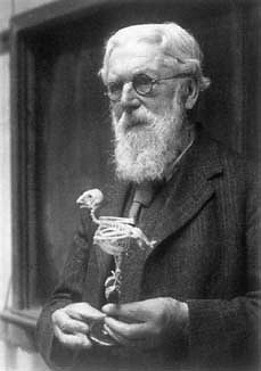Lessico
D’Arcy Wentworth Thompson

Sir D'Arcy Wentworth Thompson CB FRS FRSE (2 May 1860, Edinburgh – 21 June 1948, St Andrews) was a Scottish biologist, mathematician, and classics scholar. Was one of the most famous scientific personalities of his time – and that time was extensive, for he occupied important University chairs for a total of 64 years. He was greatly admired by many scientists, but his direct influence is hard to trace. In part, this is because some of his ideas have been accepted so entirely that they seem self-evident. Equally, it is because some of his ideas are not yet fully accepted.
D'Arcy took up the first Chair of Biology at what was then University College Dundee in 1885. He quickly acquired a reputation as an inspirational (and increasingly eccentric) teacher, while also playing an active role in local organisations such as the Dundee Social Union, the Dundee Naturalists Society and the Dundee Working Men's Field Club. During his 32 years in Dundee he founded and developed a large and impressive Zoology Museum, collecting specimens from all over the world. Although the building was demolished in the 1950s, a new version of the museum was opened in 2008, featuring many of his original specimens.
D'Arcy's collection provided the bedrock for his ongoing research into the mathematical principles of nature, work which would culminate in 1917 in the publication of his landmark book "On Growth and Form". It pioneered the science of bio-mathematics and has been hailed as "the greatest work of prose in 20th-century science." As well as continuing to inspire biologists and mathematicians today, it also proved hugely influential to such celebrated artists as Richard Hamilton, Eduardo Paolozzi and Ben Nicholson. The book was, however, just one of around 300 works published during his career.
In 1917 D'Arcy also moved to St Andrews to take up the Chair of Natural History at the University. While at St. Andrews, D’Arcy built up the Bell Pettigrew Museum of Natural History and added considerably to its displays. One correspondent reports that he met D’Arcy when he was 8, in 1932. On visiting the Museum he was hailed by the Professor, who showed the young man round its exhibits, and afterwards gave him a glass jar of stick insects, pointing out that these should be fed on fresh privet leaves.
Knighted in 1937, D’Arcy was a polymath, equally well qualified to occupy chairs of Zoology, Mathematics and Physics. His mathematical abilities are well to the fore in 'On Growth and Form', while his fluency in Greek and Latin are to be seen in his translations of Aristotle and his 'Glossary of Greek Birds' and 'Glossary of Greek Fishes'. He worked in other languages too. In the last year of his life he was teaching a group of St. Andrews students the history of Natural History. One day he was reading from a book rather hesitantly, and a student asked if he was too tired to continue. He said: ‘My dear child, I am not tired. I happen to be reading you a piece of medieval Italian, and I find the translation a little difficult, hence my hesitation.’
D’Arcy Thompson died in 1948, still teaching up to the age of 87, but before the advent of the computer era. He would have undoubtedly delighted in the abilities of computers, which could have empowered him to make his vision – still not generally accepted in its entirety – into an overwhelming case. Perhaps that might yet ensue, and his name once more regain its former eminence.